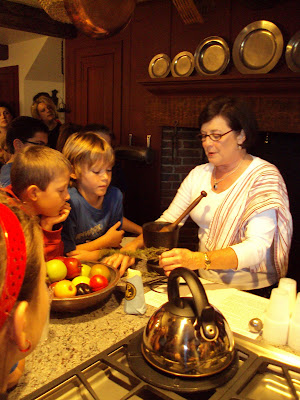
Thursday, November 19, 2009
Wednesday, November 18, 2009
Colonial Days 2009
















What fun we have had this week with our thirteen activities related to colonial life. Monday included a formal tea, tin smithing, and calligraphy in the morning and by afternoon we were making hats and wigs, cooking, and playing games. Then on Tuesday we created pomanders, practiced our weaving, and learned to quilt during the first part of the day, while the afternoon included designing a whirligig toy, making candles and learning papyrotamia. We prepared for our feast Wednesday morning by decorating our tables symmetrically with fruit, nuts and ribbon. This art form is called dellarobia and the colonial homes often featured these types of centerpieces on mantels and tables. Dancing the minuet for our parents was another memorable experience and then we enjoyed a scrumptuous meal of turkey with all the trimmings. Our principal, Mrs. Leadford, joined us for our feast as did many of our parents, enrichment teachers, Mr. Caldwell, Mrs. Catania, Big Bob, and Mr. Les. I don't believe any of us will forget these last few days for a VERY LONG time!
Saturday, November 14, 2009
Touring a Colonial Home
 Would you ever imagine that a home patterned after a New England colonial home exists within ten minutes from our school? Scott and Debra Duncan were so kind to allow our fourth graders from OCS to tour their home yesterday. They have spent the last 28 years researching colonial history and collecting authentic pieces for their home. We learned how the houses were often attached or very near the barns due to the weather extremes. We saw how a colonial kitchen might function with a reflector oven, fireplace, and other wrought iron, pewter, and kitchen tools. What a treat to taste oatmeal cooked over an open fire in a cast-iron pot! Mrs. Duncan showed us how rosemary was ground up with a mortar and and pestle. Other items of interest included seeing a handmade lock used to lock all the windows in the house and understanding how precious and costly nails were to a homebuilder as each were handmade. We learned about different types of wood used for furniture including pine, maple and mahogony. Mr. Duncan discussed some of the reasons that lead up to the Revolutionary War including taxes and laws that Britain imposed on the colonists that made life very difficult.
Would you ever imagine that a home patterned after a New England colonial home exists within ten minutes from our school? Scott and Debra Duncan were so kind to allow our fourth graders from OCS to tour their home yesterday. They have spent the last 28 years researching colonial history and collecting authentic pieces for their home. We learned how the houses were often attached or very near the barns due to the weather extremes. We saw how a colonial kitchen might function with a reflector oven, fireplace, and other wrought iron, pewter, and kitchen tools. What a treat to taste oatmeal cooked over an open fire in a cast-iron pot! Mrs. Duncan showed us how rosemary was ground up with a mortar and and pestle. Other items of interest included seeing a handmade lock used to lock all the windows in the house and understanding how precious and costly nails were to a homebuilder as each were handmade. We learned about different types of wood used for furniture including pine, maple and mahogony. Mr. Duncan discussed some of the reasons that lead up to the Revolutionary War including taxes and laws that Britain imposed on the colonists that made life very difficult.Perhaps the favorite part of our field trip was watching Mr. Duncan load a Flint lock rifle. It took several attempts to fire it, but at the last moment as we were literally watching away, the rifle finally fired, much to the delight of the fourth graders!
 A bucket hanging in a hallway would be filled with sand in case of fire. This is also a "Good Morning" stairway. There was a hallway on the left and right of the top of the stairs and members would greet each other with a "good morning" as they met at the top of the stairs each day.
A bucket hanging in a hallway would be filled with sand in case of fire. This is also a "Good Morning" stairway. There was a hallway on the left and right of the top of the stairs and members would greet each other with a "good morning" as they met at the top of the stairs each day.
Thursday, November 5, 2009
Letters to our Colonial Friends





This past week we wrote letters to the main characters from our colonial novels: Maria's Story (1773) and John's Story (1775). As we read our novels, we notice that life for children over 200 years ago carried far more responsibilities. For instance, Maria is expected to care for her younger brothers, cook meals and keep up with the housework. Going to school is not an option for her and she is intent on teaching herself to read and write so she can assist in the family business of operating the printing of the Virginia Gazette. John, on the other hand, is part of the elite gentry class and lives with many privileges including household servants. John is struggling internally with the decision to fight against the British along with his older brother, or to try a more diplomatic approach to solving problems, as his father suggests. Both John and Maria are close in age to our fourth graders.
In our letters, we asked questions about games they play, hobbies, clothing, and friendships. We also drew pictures of John and Maria based on what we have read out in our novels and other sources regarding colonial attire.
Subscribe to:
Comments (Atom)












